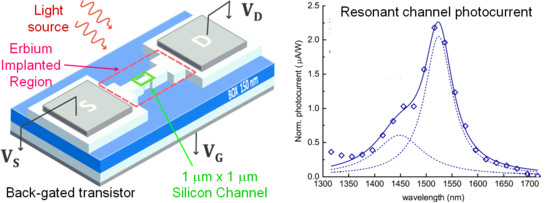Room Temperature Resonant Photocurrent in an Erbium Low-Doped Silicon Transistor at Telecom Wavelength
Abstract
1. Introduction
2. Materials and Methods
2.1. Device Fabrication and Transport Characterization
2.2. Optical Setup for Photocurrent Characterization
3. Results and Discussion
3.1. Photoluminescence Characterization
3.2. Photocurrent Characterization
4. Conclusions
Supplementary Materials
Author Contributions
Funding
Acknowledgments
Conflicts of Interest
References
- Simon, C.; Afzelius, M.; Appel, J.; Boyer de la Giroday, A.; Dewhurst, S.J.; Gisin, N.; Hu, C.Y.; Jelezko, F.; Kröll, S. Quantum memories—A review based on the European integrated project “Qubit Applications (QAP)”. Eur. Phys. J. B 2010, 58, 1–22. [Google Scholar]
- Dibos, A.M.; Raha, M.; Phenicie, C.M.; Thompson, J.D. Atomic Source of Single Photons in the Telecom Band. Phys. Rev. Lett. 2018, 120, 243601. [Google Scholar] [CrossRef] [PubMed]
- Yin, C.; Rancic, M.; de Boo, G.G.; Stavrias, N.; McCallum, J.C.; Sellars, M.J.; Rogge, S. Optical addressing of an individual erbium ion in silicon. Nature 2013, 497, 91–94. [Google Scholar] [CrossRef] [PubMed]
- Priolo, F.; Gregorkiewicz, T.; Galli, M.; Krauss, T.F. Silicon nanostructures for photonics and photovoltaics. Nat. Nanotechnol. 2014, 9, 19–32. [Google Scholar] [CrossRef] [PubMed]
- Prati, E.; Celebrano, M.; Ghirardini, L.; Biagioni, P.; Finazzi, M.; Shimizu, Y.; Tu, Y.; Inoue, K.; Nagai, Y.; Shinada, T.; et al. Revisiting room-temperature 1.54 μm photoluminescence of ErOx centers in silicon at extremely low concentration. In Proceedings of the 2017 Silicon Nanoelectronics Workshop, Kyoto, Japan, 4–5 June 2017. [Google Scholar]
- Celebrano, M.; Ghirardini, L.; Finazzi, M.; Shimizu, Y.; Tu, Y.; Inoue, K.; Nagai, Y.; Shinada, T.; Chiba, Y.; Abdelghafar, A.; et al. 1.54 μm photoluminescence from Er:Ox centers at extremely low concentration in silicon at 300 K. Opt. Lett. 2017, 42, 3311–3314. [Google Scholar] [CrossRef] [PubMed]
- Franzò, G.; Coffa, S.; Priolo, F.; Spinella, C. Mechanism and performance of forward and reverse bias electroluminescence at 1.54 μm from Er-doped Si diodes. J. Appl. Phys. 1997, 81, 2784–2793. [Google Scholar] [CrossRef]
- Priolo, F.; Franzò, G.; Coffa, S.; Polman, A.; Libertino, S.; Barklie, R.; Carey, D. The erbium-impurity interaction and its effects on the 1.54 μm luminescence of Er3+ in crystalline silicon. J. Appl. Phys. 1995, 78, 3874–3882. [Google Scholar] [CrossRef]
- Zhang, Q.; Hu, G.; de Boo, G.G.; Rancic, M.; Johnson, B.C.; McCallum, J.C.; Du, J.; Sellars, M.; Yin, C.; Rogge, S. Single rare-earth ions as atomic-scale probes in ultra-scaled transistors. arXiv, 2018; arXiv:1803.01573. [Google Scholar]
- Shinada, T.; Okamoto, S.; Kobayashi, T.; Ohdomari, I. Enhancing semiconductor device performance using ordered dopant arrays. Nature 2005, 437, 1128–1131. [Google Scholar] [CrossRef] [PubMed]
- Prati, E.; Shinada, T. Atomic scale devices: Advancements and directions. In Proceedings of the 2014 IEEE International Electron Devices Meeting, San Francisco, CA, USA, 15–17 December 2014; pp. 1.2.1–1.2.4. [Google Scholar]
- Prati, E.; Shinada, T. (Eds.) Single-Atom Nanoelectronics; Pan Stanford Publishing: Singapore, 2013. [Google Scholar]
- Shinada, T.; Prati, E.; Tamura, S.; Tanii, T.; Teraji, T.; Onoda, S.; Ohshima, T.; McGuinness, L.P.; Rogers, L.; Naydenov, B.; et al. Opportunity of single atom control for quantum processing in silicon and diamond. In Proceedings of the 2014 Silicon Nanoelectronics Workshop, Honolulu, HI, USA, 8–9 June 2014. [Google Scholar]
- Prati, E.; Hori, M.; Guagliardo, F.; Ferrari, G.; Shinada, T. Anderson–Mott transition in arrays of a few dopant atoms in a silicon transistor. Nat. Nanotechnol. 2012, 7, 443–447. [Google Scholar] [CrossRef] [PubMed]
- Prati, E.; Kumagai, K.; Hori, M.; Shinada, T. Band transport across a chain of dopant sites in silicon over micron distances and high temperatures. Sci. Rep. 2016, 6, 19704. [Google Scholar] [CrossRef] [PubMed]
- Prati, E.; Chiba, Y.; Yano, M.; Kumagai, K.; Hori, M.; Ferrari, G.; Shinada, T.; Tanii, T. Single ion implantation of Ge donor impurity in silicon transistors. In Proceedings of the 2015 Silicon Nanoelectronics Workshop, Kyoto, Japan, 14–15 June 2015. [Google Scholar]
- Fan, H.Y.; Ramdas, A.K. Infrared Absorption and Photoconductivity in Irradiated Silicon. J. Appl. Phys. 1959, 30, 1127–1134. [Google Scholar] [CrossRef]
- Geis, M.W.; Spector, S.J.; Grein, M.E.; Schulein, R.T.; Yoon, J.U.; Lennon, D.M.; Deneault, S.; Gan, F.; Kaertner, F.X.; Lyszczarz, T.M. CMOS-Compatible All-Si High-Speed Waveguide Photodiodes with High Responsivity in Near-Infrared Communication Band. IEEE Photonics Technol. Lett. 2007, 19, 152–154. [Google Scholar] [CrossRef]
- Bradley, J.D.B.; Jessop, P.E.; Knights, A.P. Silicon waveguide-integrated optical power monitor with enhanced sensitivity at 1550 nm. Appl. Phys. Lett. 2005, 86, 241103. [Google Scholar] [CrossRef]
- McKeever, J.; Boca, A.; Boozer, A.D.; Miller, R.; Buck, J.R.; Kuzmich, A.; Kimble, H.J. Deterministic Generation of Single Photons from One Atom Trapped in a Cavity. Science 2004, 303, 1992–1994. [Google Scholar] [CrossRef] [PubMed]
- Ritter, S.; Nölleke, C.; Hahn, C.; Reiserer, A.; Neuzner, A.; Uphoff, M.; Mücke, M.; Figueroa, E.; Bochmann, J.; Rempe, G. An elementary quantum network of single atoms in optical cavities. Nature 2012, 484, 195–200. [Google Scholar] [CrossRef] [PubMed]
- Shimizu, Y.; Tu, Y.; Abdelghafar, A.; Yano, M.; Suzuki, Y.; Tanii, T.; Shinada, T.; Prati, E.; Celebrano, M.; Finazzi, M.; et al. Atom probe study of erbium and oxygen co-implanted silicon. In Proceedings of the 2017 Silicon Nanoelectronics Workshop, Kyoto, Japan, 4–5 June 2017. [Google Scholar]
- Kenyon, A.J. Erbium in silicon. Semicond. Sci. Technol. 2005, 20, R65–R84. [Google Scholar] [CrossRef]
- Agostinelli, T.; Caironi, M.; Natali, D.; Sampietro, M.; Biagioni, P.; Finazzi, M.; Duò, L. Space charge effects on the active region of a planar organic photodetector. J. Appl. Phys. 2007, 101, 114504. [Google Scholar] [CrossRef]
- Celebrano, M.; Baselli, M.; Bollani, M.; Frigerio, J.; Bahgat Shehata, A.; Della Frera, A.; Tosi, A.; Farina, A.; Pezzoli, F.; Osmond, J.; et al. Emission Engineering in Germanium Nanoresonators. ACS Photonics 2015, 2, 53–59. [Google Scholar] [CrossRef]
- Miniscalco, W.J.; Quimby, R.S. General procedure for the analysis of Er3+ cross sections. Opt. Lett. 1991, 16, 258–260. [Google Scholar] [CrossRef] [PubMed]
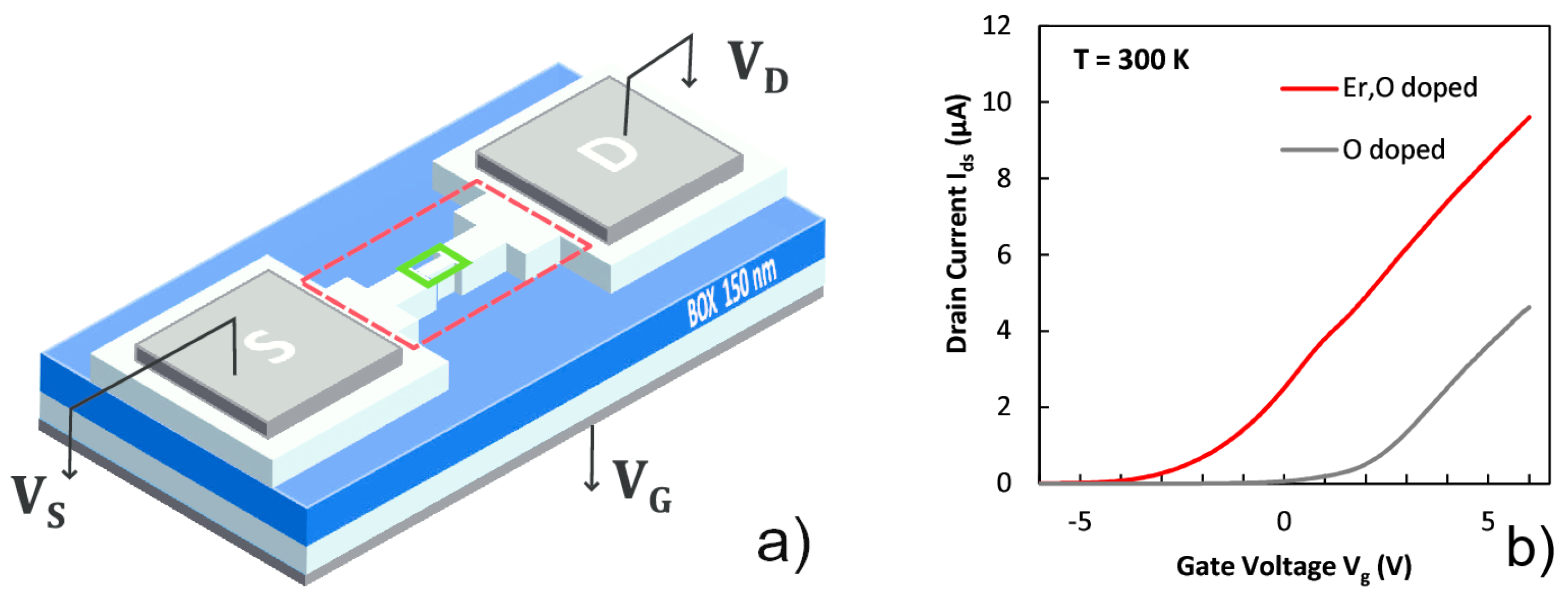
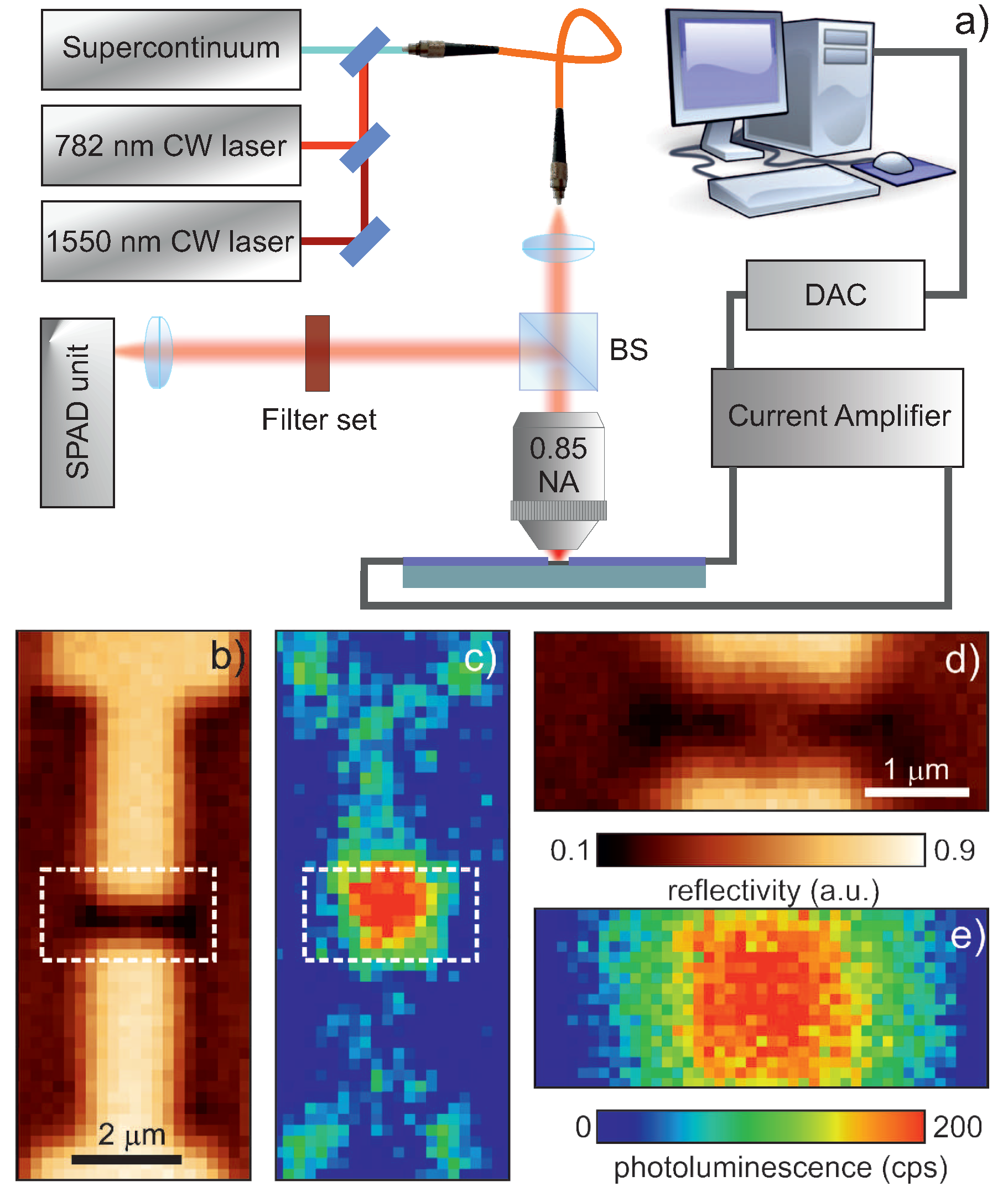
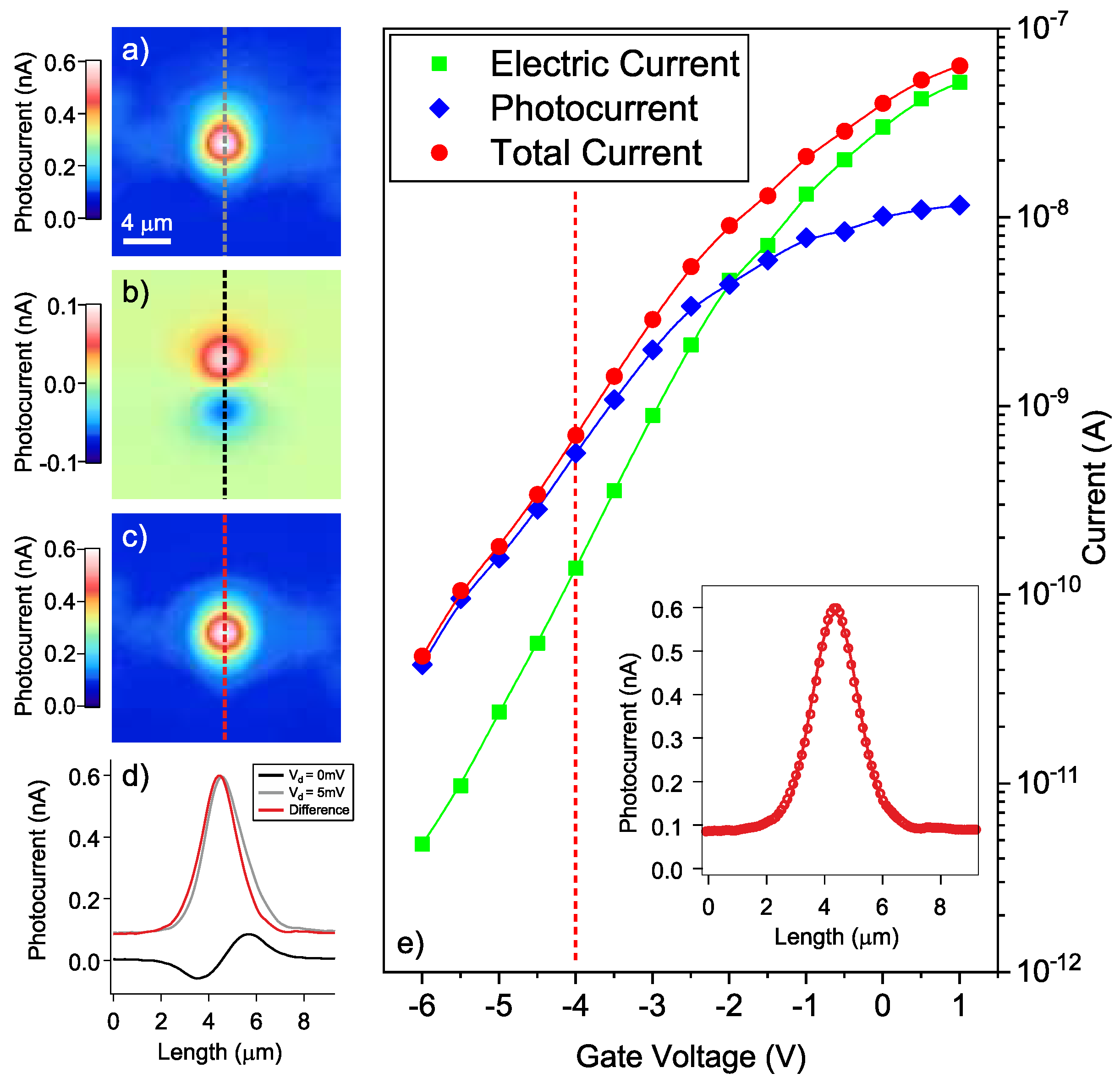
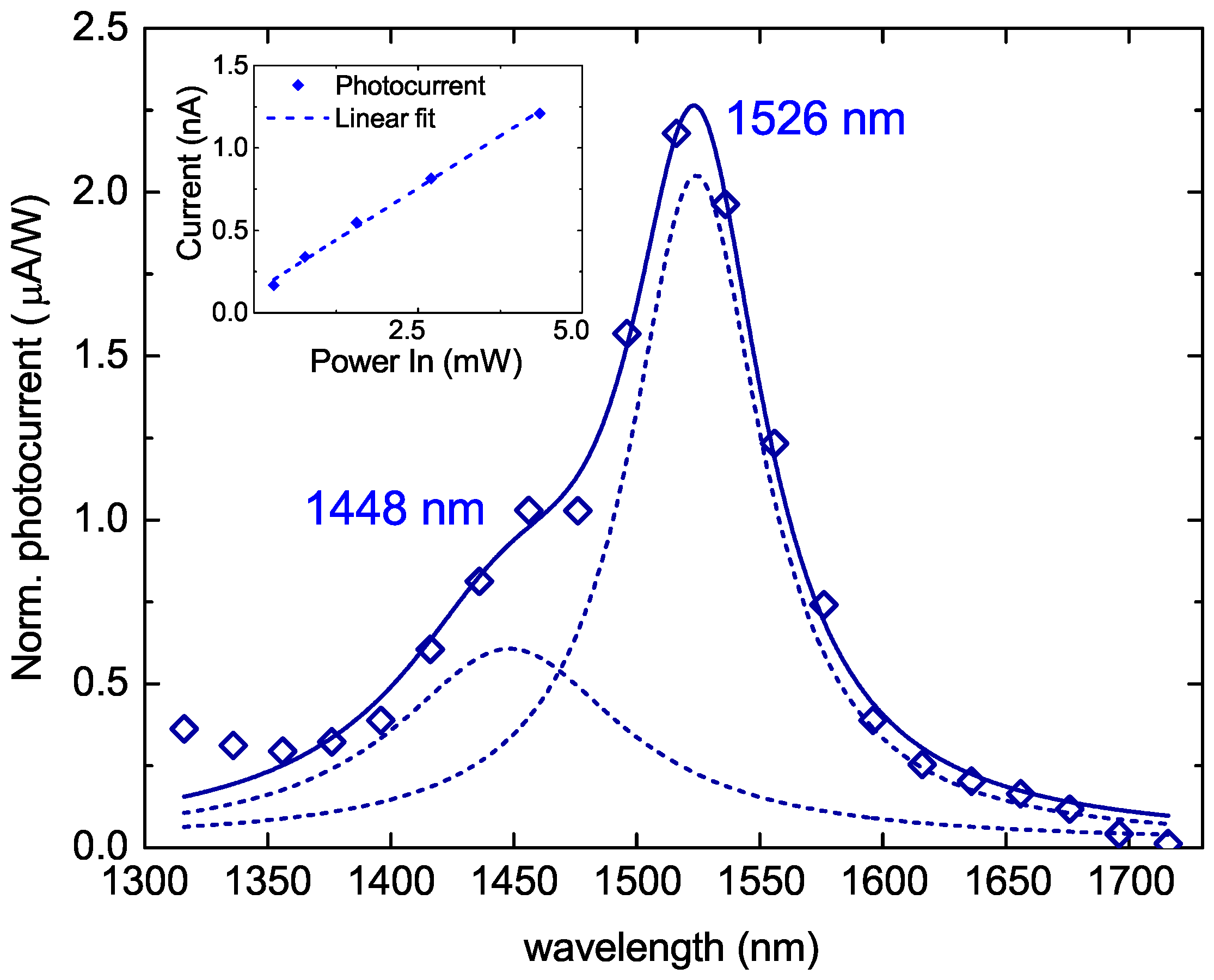
© 2019 by the authors. Licensee MDPI, Basel, Switzerland. This article is an open access article distributed under the terms and conditions of the Creative Commons Attribution (CC BY) license (http://creativecommons.org/licenses/by/4.0/).
Share and Cite
Celebrano, M.; Ghirardini, L.; Finazzi, M.; Ferrari, G.; Chiba, Y.; Abdelghafar, A.; Yano, M.; Shinada, T.; Tanii, T.; Prati, E. Room Temperature Resonant Photocurrent in an Erbium Low-Doped Silicon Transistor at Telecom Wavelength. Nanomaterials 2019, 9, 416. https://doi.org/10.3390/nano9030416
Celebrano M, Ghirardini L, Finazzi M, Ferrari G, Chiba Y, Abdelghafar A, Yano M, Shinada T, Tanii T, Prati E. Room Temperature Resonant Photocurrent in an Erbium Low-Doped Silicon Transistor at Telecom Wavelength. Nanomaterials. 2019; 9(3):416. https://doi.org/10.3390/nano9030416
Chicago/Turabian StyleCelebrano, Michele, Lavinia Ghirardini, Marco Finazzi, Giorgio Ferrari, Yuki Chiba, Ayman Abdelghafar, Maasa Yano, Takahiro Shinada, Takashi Tanii, and Enrico Prati. 2019. "Room Temperature Resonant Photocurrent in an Erbium Low-Doped Silicon Transistor at Telecom Wavelength" Nanomaterials 9, no. 3: 416. https://doi.org/10.3390/nano9030416
APA StyleCelebrano, M., Ghirardini, L., Finazzi, M., Ferrari, G., Chiba, Y., Abdelghafar, A., Yano, M., Shinada, T., Tanii, T., & Prati, E. (2019). Room Temperature Resonant Photocurrent in an Erbium Low-Doped Silicon Transistor at Telecom Wavelength. Nanomaterials, 9(3), 416. https://doi.org/10.3390/nano9030416





